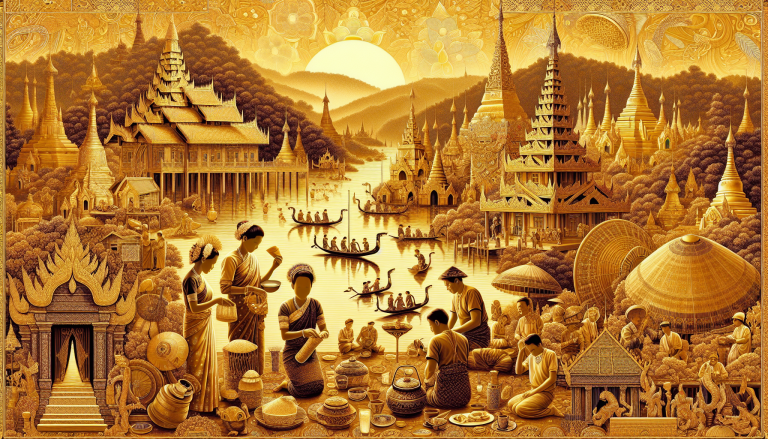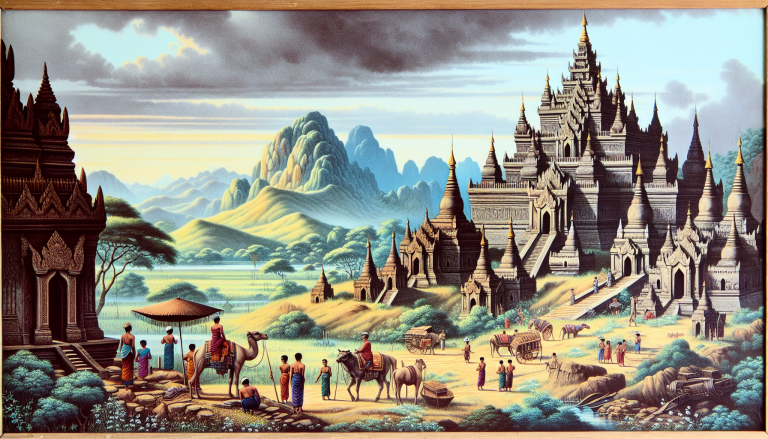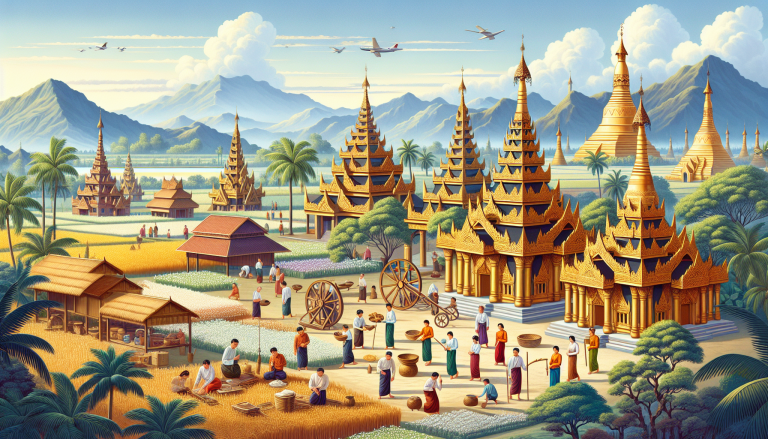Unraveling the Story: Myanmar Historical Research Unveiled
Dive into Myanmar historical research! Uncover ancient foundations, colonial impact, and rich cultural exchanges.

Ancient Myanmar State
Explore the rich history of ancient Myanmar through the lens of its influential leaders and cultural milestones. This section looks at the pivotal events that shaped the early Myanmar state, highlighting its foundation by King Anawrahta and the adoption of Theravada Buddhism.
Foundation by King Anawrahta
King Anawrahta is a towering figure in the annals of Burmese historical figures. In 1057, he founded the first unified Myanmar state at Pagan. This ambitious ruler managed to bring together various small principalities and create a cohesive political entity. The kingdom of Pagan, located in the central plains, became the heart of early Myanmar civilizations.
| Key Event | Date |
|---|---|
| Foundation of Pagan | 1057 AD |
| Reign of King Anawrahta | 1044-1077 AD |
For more detailed insights into this period, you can explore our articles on ancient Myanmar civilizations and the Bagan kingdom history.
Adoption of Theravada Buddhism
Another cornerstone in Myanmar’s history is the adoption of Theravada Buddhism. King Anawrahta played a crucial role in promoting this form of Buddhism, which he adopted in 1057 (BBC). By the 11th century, Myanmar had become the center of Theravada Buddhist practice, with the religion becoming deeply embedded in the fabric of the state.
The support of Theravada Buddhism by Myanmar’s leadership allowed it to flourish and become the ideological foundation of the Pagan kingdom. This led to the construction of numerous temples and stupas, many of which still stand today and are prominent historical sites in Myanmar.
| Key Event | Date |
|---|---|
| Adoption of Theravada Buddhism | 1057 AD |
| Rise of Pagan as a Buddhist Center | 11th Century AD |
For those interested in the religious history of this fascinating region, our piece on Theravada Buddhism in Myanmar provides an in-depth look.
Make sure to delve deeper into related topics to fully appreciate the complexity and grandeur of ancient Myanmar. From ancient art to architectural achievements, Myanmar’s history is rich and multifaceted.
Colonial Influence
The colonial influence in Myanmar, previously known as Burma, significantly altered the course of its history. Understanding this period requires a look into two major events: the British capture of Mandalay and Burma becoming a province of British India.
British Capture of Mandalay
In 1885, after a brief battle, the British managed to capture Mandalay, the last royal capital of Burma. This victory marked the end of the Konbaung Dynasty, which had ruled the region since the mid-18th century (BBC). The defeat resulted in the exile of King Thibaw, the last monarch of Burma, and the annexation of Burma into the British Empire. This event was a turning point, leading to significant political, social, and economic changes.
| Event | Date | Key Outcome |
|---|---|---|
| British Capture of Mandalay | 1885 | End of the Konbaung Dynasty, annexation by the British |
The British takeover fundamentally undermined the traditional Burmese institutions. Notably, the arrival of British colonial policy led to a replacement of the traditional education system, dominated by the Sangha (the monastic community), with a secular, modern one.
Burma as a Province of British India
Following the capture of Mandalay, Burma was fully integrated into the British Empire. By 1886, it had become a province of British India (BBC). This incorporation had profound impacts on Burmese society. For one, the economic competition between Burmans and the predominantly Muslim Bengali Indians created class divisions that had lasting effects on social dynamics.
The new colonial administration introduced modern educational reforms, which resulted in many Burmese graduates joining the colonial governance structure as civil servants. This shift led to a decline and fragmentation of the traditional Buddhist monastic education system.
| Event | Date | Key Outcome |
|---|---|---|
| Burma Becomes Province of British India | 1886 | Integration into British India |
Lay Buddhist nationalists and members of the Sangha often resisted the colonial policies. This resistance was not purely religious but also reflected nationalistic fervor. Monastic resistance led to several monks being jailed, highlighting the Sangha’s role as a counterbalance to state power (Harvard Divinity School).
For more detailed events about Myanmar’s colonial history, you can explore burmese history timeline and myanmar historical events. Interested in reading more about this subject? Check out various myanmar history books that delve deeper into these transformative years.
Independence and Post-Independence
Burma’s journey to becoming Myanmar is filled with significant historical events that have shaped its identity. Let’s explore the key moments leading to its independence.
Separation from India in 1937
In 1937, Burma was officially separated from India, becoming a crown colony under British rule. This separation marked a major shift in the administrative and political landscape of the region. Prior to this, Burma was treated as a province of British India, but the separation allowed for a distinct Burmese identity to emerge.
| Year | Event | Description |
|---|---|---|
| 1937 | Separation from India | Burma becomes a crown colony |
For a deeper dive into this period, visit our Burmese history timeline.
Assassination of Aung San in 1947
One of the most pivotal and tragic events in Burmese history was the assassination of Aung San in 1947. Aung San, a prominent leader in the fight for Burmese independence, was killed along with six members of his interim government by political opponents led by U Saw. This assassination shocked the nation and left a leadership vacuum at a crucial time.
| Year | Event | Description |
|---|---|---|
| 1947 | Assassination of Aung San | Aung San and six government members killed by political rivals |
Learn more about key figures in Burmese history by checking out our Burmese historical figures section.
Independence in 1948
Despite the turmoil, Burma achieved independence on January 4, 1948, with U Nu serving as the first prime minister. This marked the end of British colonial rule and the beginning of an era of self-governance. The country faced numerous challenges but remained determined to carve out its path.
| Year | Event | Description |
|---|---|---|
| 1948 | Independence | Burma becomes an independent nation with U Nu as prime minister |
For an in-depth look at post-independence Burma, visit Myanmar historical events.
In these years of transition, Myanmar’s rich cultural tapestry continued to evolve. If history intrigues you, explore more about Myanmar’s historical and cultural exchanges and check out books on Myanmar history.
Cultural Exchange and Isolation
In the rich tapestry of Myanmar’s historical research, one of the most fascinating aspects is its role as a hub for cultural exchange and the factors that have led to periods of isolation. Let’s explore how Myanmar became a nexus of exchange, the influences of Indian culture, and the geographical factors that shaped its culture.
Myanmar as a Nexus of Exchange
Myanmar has been a central point for cultural and material exchange for thousands of years. It attracted merchant ships from distant lands such as India, Sri Lanka, and beyond, contributing to its rich cultural milieu. This influx of foreign goods, ideas, and customs has significantly influenced Myanmar’s society, arts, and crafts while allowing them to retain their unique local traditions.
Regular trade routes passed through Myanmar, turning it into a vital point of commerce and culture in Asia. This historical crossroads enriched Myanmar, making its cultural heritage diverse and vibrant. For more information on how Myanmar’s historical events have influenced its current state, visit myanmar historical events.
Influences of Indian Culture
India’s influence on Myanmar is evident in various aspects of its culture. The introduction of Theravada Buddhism, which became the state religion by the 11th century under the support of Myanmar’s leadership, is one of the most profound impacts (Britannica). This religious influence has permeated every layer of Myanmar society, from architecture to daily practices.
Traditional clothing, jewelry, and hairstyles in Myanmar often reflect Indian styles, as do elements of language and cuisine. India’s impact was also significant in shaping Myanmar’s art and architecture, with many temples and sculptures bearing distinctly Indian traits.
| Aspect of Culture | Indian Influence |
|---|---|
| Religion | Theravada Buddhism |
| Clothing | Traditional garments and jewelry |
| Language | Lexical elements |
| Cuisine | Spices and dishes |
| Architecture | Temple styles |
For a deeper dive into the cultural and historical exchange between Myanmar and India, refer to our article on myanmar history and culture.
Geographical Factors on Culture
Geography played a key role in shaping Myanmar’s culture. Situated between India and China, Myanmar became a natural trade and cultural bridge. The monsoon wind patterns facilitated maritime activities, making coastal and riverine regions particularly active in international trade.
Furthermore, Myanmar’s varied topography—from the central lowlands where the Pagan city thrived to the mountainous regions—fostered diverse cultural practices among different ethnic groups. This geographical diversity led to a blend of cultural practices, influenced by various migrating tribes and neighboring civilizations.
| Region | Cultural Influence |
|---|---|
| Coastal Areas | Indian and Sri Lankan merchants |
| Central Plains | Theravada Buddhism and local traditions |
| Mountains | Tribal cultures and unique traditions |
To better understand how geography has influenced cultural practices in Myanmar, explore our detailed section on myanmar geographical factors.
The story of Myanmar is rich with cultural exchanges and periods of isolation, each leaving its mark on the country’s identity. By studying these interactions, you gain a deeper appreciation for the complexity and resilience of Myanmar’s culture. This vibrant historical narrative is an essential part of the broader southeast asian civilizations.






